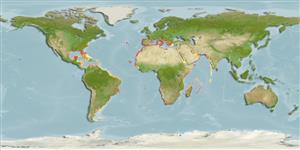>
Blenniiformes (Blennies) >
Blenniidae (Combtooth blennies) > Salariinae
Etymology: Parablennius: Greek, para = the side of + Greek, blennios = mucus (Ref. 45335).
More on author: Cuvier.
Environment: milieu / climate zone / depth range / distribution range
Ecologie
marien demersaal; diepte 0 - 25 m (Ref. 5298). Subtropical; 44°N - 56°S
Eastern Atlantic: Spain and Portugal to Möwe Bay, Namibia. Also in the Mediterranean along the coast from Morocco, Algeria, Spain. Southwest Atlantic: Brazil and Patagonia, Argentina (Ref. 4404). Western Indian Ocean: Natal to Knysna in South Africa.
Grootte / Gewicht / Leeftijd
Maturity: Lm ? range ? - ? cm
Max length : 12.7 cm SL mannelijk / geslacht onbekend; (Ref. 5298)
Dorsale stekels (totaal) : 11 - 12; Dorsale zachte stralen (totaal) : 18 - 24; Anale stekels: 2; Anale zachte stralen: 20 - 25. Body with up to 9 dusky bands above and dark spots below; sometimes pale with irregular dusky marks; 2 dark bands on underside of head; pectorals pale to dusky pale in color; dorsal fin dusky or with many spots (Ref. 4404).
Facultative air-breathing in the genus (Ref. 126274); Adults occur in rocky shores, often at steep walls of surf-exposed sites (Ref. 5981). Oviparous. Eggs are demersal and adhesive (Ref. 205), and are attached to the substrate via a filamentous, adhesive pad or pedestal (Ref. 94114). Larvae are planktonic, often found in shallow, coastal waters (Ref. 94114).
Levenscyclus en paargedrag
Maturities | Voortplanting | Spawnings | Egg(s) | Fecundities | Larven
Oviparous, distinct pairing (Ref. 205).
Springer, V.G., 1986. Blenniidae. p. 742-755. In M.M. Smith and P.C. Heemstra (eds.) Smiths' sea fishes. Springer-Verlag, Berlin. (Ref. 4404)
Status op de Rode Lijst van het IUCN (Ref. 130435)
Gevaar voor de mens
Harmless
Gebruik door de mens
Tools
Speciale rapporten
Download XML
Internetbronnen
Estimates based on models
Preferred temperature (Ref.
123201): 18 - 27.9, mean 26.4 °C (based on 1539 cells).
Fylogenetische diversiteitsindex (Ref.
82804): PD
50 = 0.5000 [Uniqueness, from 0.5 = low to 2.0 = high].
Bayesian length-weight: a=0.01072 (0.00457 - 0.02514), b=3.01 (2.83 - 3.19), in cm total length, based on LWR estimates for this Genus-body shape (Ref.
93245).
Trofisch niveau (Ref.
69278): 3.2 ±0.40 se; based on food items.
Weerstandsvermogen (Ref.
120179): Hoog, minimale populatieverdubbelingstijd minder dan 15 maanden (Preliminary K or Fecundity.).
Fishing Vulnerability (Ref.
59153): Low vulnerability (10 of 100).
Nutrients (Ref.
124155): Calcium = 185 [102, 374] mg/100g; Iron = 1.38 [0.88, 2.36] mg/100g; Protein = 18.8 [17.9, 19.6] %; Omega3 = 0.373 [0.230, 0.607] g/100g; Selenium = 15.1 [8.2, 30.1] μg/100g; VitaminA = 23.9 [8.3, 66.4] μg/100g; Zinc = 1.19 [0.85, 1.71] mg/100g (wet weight);
